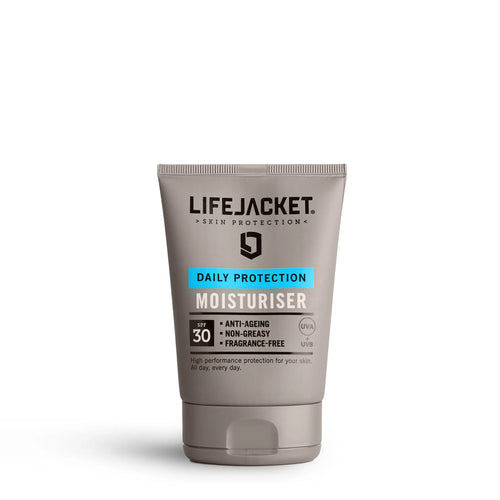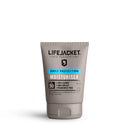It's amazing how misunderstood the term Sun Protection Factor (SPF) is. Particularly considering it's such an important driver in people's purchase decision when it comes to skin protection and sunscreen. That's why we've decided to demystify SPF in 10 straight-talking points, just how we like it.
#1 The sun's rays
Rays from the sun reach the earth. Some we can see. Some we can’t. The rays we can’t see are called ultraviolet light. Ultraviolet light or ‘radiation’ comes in different wavelengths: UVA, UVB and UVC.

#2 UV rays broken down
UVC doesn’t make it to earth.
UVB does a bit.
UVA does a lot.
Poor English, we know...it was intentional.
#3 UV damage
We repeat this a lot in the LifeJournal, but the World Health Organisation classifies ultraviolet radiation as a proven human carcinogen — meaning there’s clear evidence that it causes cancer.
To support that, research shows that most melanomas are linked to ultraviolet light from the sun — both UVA and UVB. It’s a strong connection, but not an exact percentage, as risks vary by country and behaviour.
#4 Focusing on UVB
UVB is the main cause of sunburn and the strongest contributor to photo-ageing.
UVA penetrates deeper into the skin and adds to the damage by breaking down collagen and elastin over time. Together, both UVA and UVB weaken the skin’s structure, which is why daily protection makes such a visible difference.
#5 Repeating ourselves
Too much UVA or UVB radiation can damage the DNA in our skin cells. DNA tells our cells how to function. If enough DNA damage builds up over time, it can cause cells to start growing out of control, which can lead to skin cancer.
See point #3. We thought it was worth wasting a point to reiterate this.
#6 Block UVA and UVB
A good sunscreen blocks both UVA and UVB. This is what broad spectrum means on some sunscreen product labels. Always buy broad spectrum or products that say they protect against UVA and UVB on the packaging.
#7 Sun Protection Factor and UVB
Getting to the nuts and bolts….
SPF measures protection against sunburn — mostly caused by UVB, though there’s a small UVA contribution. It doesn’t directly measure UVA protection, which is why you should always look for a product with the “UVA in a circle” logo or a high UVA star rating.
#8 Burn factor
Without any protection, the human skin will burn when exposed to UV. We’ve all been caught off guard, right?
If you’re fair, this could be as little as 5 minutes. If you’re darker, it could be 10-15 minutes. This is called your 'burn time'.
#9 Quick maths
If you use an SPF 10 product and your burn time is, say, 10 minutes, the product you're using will protect you for 100 minutes before you need to reapply.
i.e. (SPF 10) x (your burn time of 10 minutes) = 100 minutes total protection time.
Where everybody goes wrong is dosage.
If you use too little, you’re effectively reducing the SPF on the left-hand side of the formula. SPF 10 could become SPF 5 because you used half the recommended amount. You got it: 100 minutes quickly becomes 50 minutes. When people say, 'I burnt even though I had sunscreen on', this is nearly always the reason.
We wrote an article here on the correct sunscreen dose.
#10 Testing, testing
For those of you interested, this is how a European sunscreen product gets 'awarded' its SPF rating....
Firstly, the exercise is carried out according to an international standard and must be performed under dermatological control in an accredited laboratory.
The test itself uses a special lamp that simulates the sun's UV light. The lamp is pointed onto the skin of a test human with and without the sample sunscreen. The response of that area of skin to the lamp allows the lab to determine the protection provided.
The way a product is judged to work (or not) is if the skin shows signs of erythema - a fancy way of saying skin reddening or sun burn. To create a comparison, one area of skin is exposed to the lamp without any protection and another is exposed with the sunscreen. Finally, a third area is exposed using an SPF reference product for validation.
To determine the SPF of the sunscreen being tested, sunburn is induced on several small sub-sites on the skin. These responses are visually assessed by a dermatologist for the presence of redness, 16-24 hours after the UV radiation.
The result is an SPF score based on how the skin responded with the test sunscreen. This is called an in vivo test. Obviously, as LifeJacket products are all clinically and dermatologically tested, our products have been scrutinised by these tests.
Conclusion
Hopefully, you now understand that the higher the SPF, the longer you are protected for. It's just a straight forward multiplication by your own personal burn time. And that's why we always err on the side of caution and recommend people choose a higher SPF. It means less re-application and also accounts for the fact that we don't always use enough so might be under-protecting ourselves.
Hope that helps folks!







